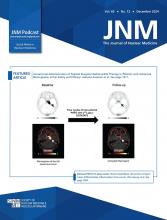Visual Abstract
Abstract
177Lu-PSMA-617 (LuPSMA) is a newly established treatment for patients with metastatic castration-resistant prostate cancer (mCRPC), but survival outcomes vary widely, and predictors of treatment responses are needed. This study investigated the role of total tumor volumes (TTVs) and new lesions (NLs) determined by LuPSMA SPECT/CT in early cycles to predict subsequent outcomes in a real-world practice setting. Methods: Between June and December 2022, consecutive patients with mCRPC who received at least 2 administrations of LuPSMA with SPECT/CT 24 h after treatment were retrospectively reviewed. We evaluated associations between TTVs and the appearance of NLs at cycles 2 and 3 with subsequent prostate-specific antigen (PSA) progression-free survival and overall survival (OS) using multivariate Cox regression. All analyses were adjusted for changes in PSA level relative to baseline. Results: Sixty-six mCRPC patients (median age, 74 y) received a median of 4 (interquartile range, 3–5) cycles of LuPSMA. Median follow-up starting at cycle 2 was 42 wk (interquartile range, 33–48 wk), with 24 of 66 patients deceased at the time of the analysis. Changes in TTV measured at the start of cycles 2 and 3 relative to baseline correlated significantly with corresponding changes in PSA level (r = 0.55 and 0.56), but absolute TTVs did not correlate significantly (r = 0.00 and 0.18). Patients with a higher absolute TTV at the start of cycle 2 had worse PSA progression-free survival and OS (hazard ratio [HR], 1.4 [95% CI, 1.1–1.8] and 2.1 [95% CI, 1.5–2.9]), with consistent results at the start of cycle 3 (HR, 2 [95% CI, 1.4–2.9] and 2 [95% CI, 1.2–3.2]). NLs were identified in 13 of 66 and 11 of 51 patients at the start of cycles 2 and 3. NLs at the start of cycle 2 were associated with worse OS (HR, 5.8 [95% CI, 1.9–17.5]), with consistent results at the start of cycle 3 (HR, 4.9 [95% CI, 1.3–18.6]). In multivariate analysis, a higher TTV and the appearance of NLs at the start of cycles 2 and 3 were independently associated with poorer OS. Conclusion: Higher TTVs and NLs on LuPSMA SPECT/CT at the start of cycles 2 and 3 were independently associated with higher risk of death. These measures provided prognostic information independent of changes in PSA. Development of prognostic and predictive models including TTV, NLs, and PSA changes is warranted.
- radionuclide therapy
- SPECT/CT
- new lesions
- PSMA radiopharmaceutical therapy
- response assessment
- tumor volume
Footnotes
Published online Nov. 7, 2024.
- © 2024 by the Society of Nuclear Medicine and Molecular Imaging.
This article requires a subscription to view the full text. If you have a subscription you may use the login form below to view the article. Access to this article can also be purchased.
SNMMI members
Login to the site using your SNMMI member credentials
Individuals
Login as an individual user








